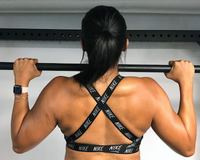

Improving our cardiovascular health should be a priority among all of us. Strengthening your heart can help lower blood pressure and cholesterol, which can significantly reduce your risk of heart disease. When it comes to cardio, there are two main forms: HIIT (High-Intensity Interval Training) and Steady State cardio. More precisely, HIIT involves repeated bouts of all-out, high effort spaced with periods of rest or active recovery. On the other hand, Steady State cardio involves exertion at a consistent pace, typically for a longer period of time without any bursts of maximum intensity.
However, within HIIT and Steady State cardio, there are various different forms. HIIT cardio can involve short, moderate or long durations. This means that a short duration HIIT cardio workout would involve 10-15 seconds of high-intensity work intervals, whereas moderate duration and long duration would involve about 20-45 seconds and 1-5 minutes of high-intensity work intervals, respectively.
Similarly, Steady State cardio involves various intensities including low-intensity, moderate intensity and hard Steady State. Because Steady State is a consistent pace throughout, low-intensity means less than half of your maximal effort; it typically lasts 45-60 minutes. This is the form that is most popular and also known as LISS (Low Intensity Steady State) cardio. Moderate intensity is slightly more challenging, lasting for about 30 minutes. Finally, hard Steady State cardio may last 10 minutes to up to even 2 hours! The main key of hard steady state is pushing yourself and maintaining an elevated heart rate for the entirety of the workout.
We will now break down the two most popular forms of cardio: LISS vs. HIIT
Which Form of Cardio is Superior?
For a long time, it was held that LISS cardio was the better option for fat loss as it tends to use more fat as fuel whereas HIIT tends to utilize more carbohydrates for fuel. However, in the last 10-15 years, much research has demonstrated that in the end, it doesn’t matter what fuel you are burning during the session itself, but what happens to the fat balance over a 24 hour period. Recent studies have concluded that while you may not utilize or burn fat during the HIIT session, you will burn more fat after the session has ended. This is called the "after-burn effect" or EPOC (Excess Post-exercise Oxygen Consumption) that occurs with HIIT, which causes you to consume more oxygen after the workout. This leads to an increased metabolism and more calories burned.
On the other hand, with LISS cardio, you miss out on this post-exercise effect–you burn calories only during the session as Steady State cardio does not create EPOC. While the after-burn effect has been supported by significant evidence when it comes to fat loss, HIIT may not be worth all the hype. In one study (2008), subjects who performed high intensity cardio for 80 minutes had an EPOC effect that lasted for 7 hours after exercising, resulting in only 80 calories burned after the session. In a more recent meta analysis by Keating, Johnson et al., it was concluded that overall EPOC is unlikely to contribute to greater fat loss potential with HIIT. In 2017, Wegete et al found that across 13 studies, “there was no significant difference between HIIT and MICT (Moderate Intensity Continuous Training) [Steady State] for any body composition measure.”
The Main Benefits of HIIT

Given that both forms of cardio aid with fat loss, HIIT still has many benefits. The main advantage of doing HIIT is that it is much more time efficient than LISS. In the same meta-analysis, HIIT was found to necessitate almost half (40%) the time required for LISS. This means you can get the same fat loss with almost half the time investment.
Aside from time-efficiency, HIIT is also less boring for most people, which makes it easier to adhere to. Furthermore, research suggests that HIIT can further reduce appetite for most people. It can also help you retain lean muscle mass. Based on one study’s findings, “..the MICT group experienced significantly decreased total lean mass and leg lean muscle mass. Meanwhile, total lean muscle mass and leg lean muscle mass in the HIIT group were unchanged. ”
Finally, because it’s harder to perform, individuals who practice HIIT feel like they are pushing themselves much more; this makes it more rewarding as well.
THE MAIN BENEFITS OF LISS

Steady State cardio can be a great tool for fat loss for many bodybuilders and physique-based sports because it is much less taxing on the body when done in low intensity. This also means you can work on your cardiovascular endurance without taxing your central nervous system. When our central nervous system is fatigued, recovery is compromised, sleep becomes difficult and concentration is decreased.
Another benefit of LISS is that it is easier on the joints, making it easier to recover from. LISS also makes it possible to multitask while you do it because it is easier to do and requires less focus. Finally, because it’s easier to perform, LISS is appropriate for people of all fitness levels.
The Bottom Line:
In summary, there isn’t one form of cardio that is superior: both have benefits and drawbacks. There are also many subcategories within both forms. Although both LISS and HIIT can burn the same amount of calories and lead to fat loss, HIIT can help you burn it much faster. However, LISS is great for burning additional calories without impairing muscle recovery or taxing the CNS system. Both forms of cardio strengthen your heart, improve cardiovascular health and reduce risk of heart attack or stroke. It is important to note that cardio is a tool for fat loss, but the right nutrition plan and strength training program always come first. After all, both HIIT and LISS can coexist in your training program!
Join the Invasion!
This Anabolic Aliens membership will grant you access to workout classes, rehab programs, diet plans, and more exclusive content to help you achieve sustainable success!










